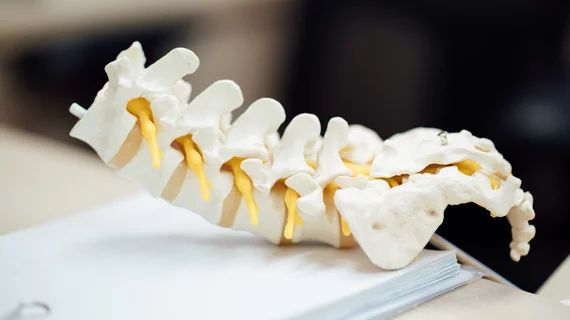Artificial intelligence significantly reduces lumbar spine MRI interpretation times
An artificial intelligence tool can significantly reduce lumbar spine MRI interpretation times among physicians, according to new research published in the European Journal of Radiology [1].
Assessing lumbar spinal stenosis can be a “repetitive and time-consuming activity,” with different grading systems resulting in a lack of consistency. Experts with Sengkang General Hospital in Singapore recently tested the use of a deep learning system to simplify the process among novice radiologists.
Using a data set of 51 lumbar spine MRIs, the study produced measurable gains. Average interpretation time per MRI study with AI assistance dropped from about 23 minutes down to 9, alongside other benefits.
“This study has shown that employing a deep learning model for analyzing MRI scans of lumbar spinal stenosis leads to significant time savings and improvements in interobserver agreement for radiology in-training residents,” Yi Xian Cassandra Yang, with the hospital’s department of radiology, and co-authors wrote July 16. “As AI enters the mainstream of clinical medicine, it is expected to enhance the clinical efficiency of healthcare workers, aid in more effective prioritization of radiology tasks, and reduce the time taken by radiologists to interpret results. This valuable tool has the potential to streamline the daily tasks conducted by radiologists, and we believe that the integration of AI will complement the work carried out in the field of radiology.”
For the study, Southeast Asian imaging experts utilized the CoLumbo AI software solution from Smart Soft Healthcare in Bulgaria. Cleared by the U.S. Food and Drug Administration in 2022 the product helps segment and classify MR images, providing suspected pathology descriptions, findings and measurements. It also generates annotated, post-processed MR images and an editable auto-generated report, Yang and colleagues noted.
CoLumbo was first trained using 4,000 fully annotated lumbar studies, comprising 160,000 MRI slices. At Sengkang General Hospital, researchers compared the performance of four consultant radiologists against four in-training residents. Four board-certified rads in musculoskeletal/neurological care with at least eight years of experience each first read the 51 images from the test data set without any help from AI. Yang and colleagues then assigned the images to four final-year radiology trainees who could not view the original reports.
The interquartile range for interpretation time with AI assistance was about 5.29 minutes versus 56.46 without. This smaller IQR indicates that interpretation times were more consistent and less variable with the help of deep learning, the authors noted. Further testing showed that average difference in interpretation times between the two groups was about -14.08 minutes, which was deemed statistically significant.
Yang and colleagues also used the consulting rads’ reports to serve as a reference standard. Residents exhibited a high degree of agreement with the expert physicians in their grading of the severity of stenosis, “as evident by the review of finalized reports by consultants and edited AI reported by residents.”
“By incorporating AI in spine reporting, its ability to expedite processes without compromising accuracy would have favorable overall economic implications towards enhanced cost-effectiveness within the healthcare industry,” the authors noted. “AI's capacity to interpret information with fewer MRI sequences has the potential to reduce scan time, and thus contribute to a more streamlined and time-effective diagnostic process. The introduction of AI to radiology residents could result in an increasing dependence on this technology, as residents may rely more on AI for their learning experiences.”
Read more, including potential study limitations, at the link below.

